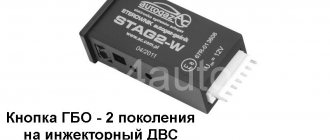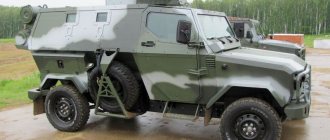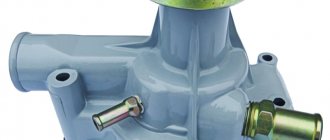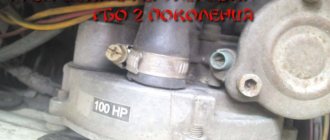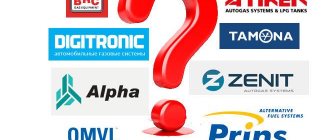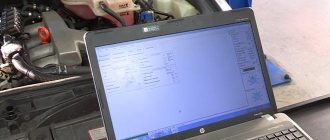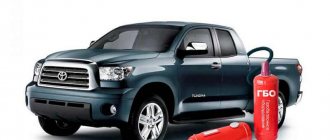Looking for an alternative to gasoline
Gas is much cheaper than gasoline and it is enough to install special gas equipment on your car and refueling costs will decrease.
Attempts to use gas as a fuel for cars have been made almost since the advent of the automobile.
But much later, a set of equipment appeared, with which it was possible to convert any car to run on gas.
Passenger cars use equipment that runs on liquefied gas (propane-butane). It is not advisable to use compressed gas on such vehicles due to the large weight of the cylinders.
Several generations of this equipment are produced, in accordance with the design features of the car and Euro toxicity standards:
- HBO 1st generation. Toxicity is below Euro, used on carburetor cars and on cars with a monoinjector;
- HBO 2nd generation. Toxicity up to Euro-2, also installed on carburetor and injection cars;
- HBO 3rd generation. Toxicity up to Euro-3, used on injection cars;
- HBO 4 generations. Toxicity – Euro-4, used on injection cars;
- HBO 5th generation. Provides precise control of liquid gas injection. The operating principle is 100% similar to the operation of the gasoline system;
- HBO 6th generation. It differs from the 5th in the presence of a fuel substitution unit - FSU, to which gas and gasoline are simultaneously suitable. The operating principle of all systems will be discussed in the following articles.
Setting the “response” to pressing the gas pedal and the amount of gas supplied
Once the idle speed has been set, it is necessary to ensure that the engine responds quickly and picks up speed when you press the gas. To do this, you need to gradually unscrew the sensitivity adjusting screw until the idle speed begins to change. As soon as a change in idle speed has been noticed, the specified screw must be screwed back 2/3 of 1 full turn or one and a quarter turns (depending on the particular internal combustion engine, etc.).
When finished, you need to press the gas pedal, first smoothly, then you can press it sharply. The main thing is that if the setting is done correctly, there should be no failures, the engine should quickly exit the idle mode, respond adequately to pedaling, rev up well and respond quickly to any pressing of the gas pedal.
- After the settings have been completed and the response to the gas pedal is satisfactory, you need to move on to the settings of the dispenser itself. To do this, you should raise the speed, on average, to 3 or 3.5 thousand rpm without suction. For these purposes, it is better to invite an assistant who will press the gas.
So, when the position of the screw leading to a change in speed has been found, the screw should be unscrewed from this position by half or 3/4 of a quarter of a turn. Please note that if a dispenser is installed that has two sections, then all the manipulations described above are carried out with the first chamber.
The second chamber is set to 1/3 of the first. If the reducer also has the ability to adjust the pressure of the first stage, then additional actions will be required.
- First of all, the engine must be turned off, after which the gas line is closed. Then a pressure gauge is connected to the cavity of the first stage. The connection itself is made through a control hole, which is closed with a screw.
- As for the pressure gauge, the device should have a scale of 1.5 kgf per square centimeter. After connecting, open the gas supply and start the engine. In idle mode, the pressure in the first stage is adjusted using the pressure gauge.
- The indicator should remain 0.38-0.42. Having set the pressure, adjustments to the idle speed and sensitivity of the gearbox should be carried out again.
HBO 3rd generation, operating principle
If the first two generations are considered obsolete, although the 2nd generation LPG is used quite actively due to its reliability and simplicity of design, the last two generations are considered more modern.
Although the difference between the 3rd generation HBO is not so striking from the 2nd generation HBO, the difference is only in some elements.
The emergence of a more advanced 4th generation, as well as stricter Euro-3 standards, has led to the fact that the use of the 3rd generation has decreased significantly. Now owners prefer to use either the second or 4th generation.
As already said, the difference between the second and third generations is insignificant. It comes down to fuel supply.
In the second, the dosage is carried out due to vacuum, and in the third, the dosage is carried out electronically.
If in the second generation the gas supply is carried out by connecting elements of gas equipment to the standard power system, then in the third generation the gas already goes directly to the intake manifold.
The design of the 3rd generation of gas equipment implies the presence of a distributor with a step-by-step metering device and mechanical injectors that supply gas to the intake manifold when excess pressure is created in them.
The metering device is controlled by an electronic control unit, which sends signals to the distributor based on the readings of the lambda probe and the throttle position, the so-called lambda control.
In fact, a gas power system is installed on the car in parallel with the standard gasoline system.
To prevent the car's on-board computer from experiencing an emergency operation, the LPG design instead of a gasoline valve that shuts off the flow of gasoline includes gasoline injector emulators, which send signals to the on-board computer about the supposedly normal operating mode of the injectors.
The principle of operation of the 3rd generation gas equipment is reduced to supplying gas to the distributor, which, based on signals from the control unit, doses the amount of gas and supplies it to gas injectors installed on the intake manifold.
A significant disadvantage of this generation of gas equipment is the very slow response of the electronic unit and mixer to changes in the operating mode of the power plant.
Features of the 3rd generation of gas equipment
This generation was created by improving the earlier 2nd generation technology. Thus, the 3rd generation is practically no different, except for small but quite significant details.
- Fuel dosage. This is where the key difference lies. In second generation systems, fuel was supplied through vacuum; the supply system was produced electronically.
- Fuel supply system. In the 2nd generation, the gas system is connected directly to the standard one, in the third, the gas is directed to the intake manifold using a stepper device and mechanical nozzles for dosing. Gas enters the system when high pressure is created.
- Euro standards requirements. The third generation meets Euro-3 toxicity standards, changes in which have led to a reduction in the use of this type of gas equipment.
In addition, one of the features of the 3rd generation is the fact that the gas system is mounted in parallel with the gasoline one.
The amount of fuel is determined using the lambda probe and throttle valve readings, which are read by a special electronic control unit.
Therefore, the operating principle can be described in several stages:
- gas is supplied to the distributor;
- the control unit reads the required amount of fuel and sends a signal;
- the distributor dispenses fuel;
- gas is supplied to the intake manifold injectors.
The main and significant disadvantage of this power system is the slow speed of changing the operating mode, since the control unit is quite slow.
3rd generation gas equipment design
Most elements of the 3rd generation HBO are identical to earlier generations of equipment. The gas is placed in a cylinder with a multi-valve installed on it. To fill the cylinder, a remote filling device is used.
High-pressure pipelines emerge from the multivalve and go into the engine compartment to the gas valve.
Pipelines go from it to the mixer reducer. A gas valve control unit is installed in the cabin.
Pipelines extend from the gearbox to a distributor with a stepper device, installed near the intake manifold. And pipelines to the injectors already extend from the distributor.
The design also includes an injector emulator that shuts off the flow of gasoline into them, while creating a signal to the standard fuel system control unit about their appropriate operation.
Advantages and disadvantages
The advantages of 3rd generation HBO include:
Possibility of use on both injection and engines equipped with a carburetor (with some modifications).
- Maintaining simplicity of design.
- Possibility of simple installation and installation.
- Simplicity and accessibility of adjustment of the mechanical and electrical parts
But there were also shortcomings that actually “buried” the 3rd generation HBO:
The main and very significant one is the very slow response to feedback from the engine. This leads to inefficient operation of the engine in its transient operating modes.
Further development and introduction of electronics, new circuits and approaches ensured the emergence of a new generation - HBO 4.
Installation of equipment on injection cars
Most of the 3rd generation HBO elements are installed on injection cars in the same way as earlier generation equipment.
The cylinder, depending on the characteristics of the car, is installed either in the trunk or in place of the spare wheel and secured.
A filling device is installed under the bumper or on the rear fender.
Fuel lines are laid at the location where the gas pipeline is installed. Under the hood, usually on the left side near the fender, a gas valve is attached.
The control unit is inserted into the cabin.
A mixer gearbox is installed not far from the engine on the left side. It is installed there to ensure its connection to the cooling system.
A distributor is installed near the intake manifold. To install gas injectors, holes are made in the manifold. An emulator is connected to the injectors of the injection system.
The control unit is connected to the wiring coming from the lambda probe and the throttle position sensor.
Then all connections are checked for the absence of etching of gas and gas equipment.
Using 3rd generation HBO on an injector
HBO 3rd generation on an injector has positive reviews. The installation does not have any pitfalls, as is the case with a carburetor, and is practically no different from the installation of systems of previous generations.
Almost always, the gas cylinder is located in the trunk, in the place where the spare tire is usually stored, and the filling device is located in the rear of the bumper or fender.
The gas lines are routed through the gas line, and the valve is routed to the left side of the hood. There, to the left of the engine, the mixer is mounted. This arrangement allows you to easily connect it to the cooling system. The distribution mechanism is placed directly next to the manifold, and the LPG control system is brought into the car interior.
3rd generation gas equipment is installed on the injector quite simply. All that is needed is a detailed installation diagram of the system for a specific car model, which can easily be found on the Internet.
It is very important to adjust the system and check it for malfunctions, first of all, to eliminate the possibility of gas bleeding.
Installation of equipment on a carburetor car
Theoretically, 3rd generation LPG can also be connected to a carburetor car, since this equipment is equipped with its own control unit.
When installing on such a car, you will not need an injector emulator, but you will need a gasoline valve that shuts off the flow of gasoline.
But without a lambda probe and throttle sensor, the equipment will not be able to work, so you will have to solve this problem, which is not so easy.
You can, of course, replace the distributor with an electronic control unit with a conventional vacuum reducer-regulator, but then the equipment will belong to the 1st generation.
Carburetor cars with HBO 3
A carburetor car can also use the installation of 3rd generation gas equipment, this is due to the fact that the equipment has its own control unit. It is also worth noting that in this case you will not need an injector emulator, which supplies fuel and at the same time provides the on-board computer with normal operation. This occurs when the engine is running using gas fuel.
But due to the inability to use an injector emulator, there is a need to use a gasoline valve, which in turn stops the gasoline. And there is one more small nuance in which the normal functioning of the carburetor car system will not be carried out - this is the mandatory use of a throttle sensor and a lambda probe. Solving this problem is necessary, but, unfortunately, it is not so simple.
A carburetor car practices replacing the distributor and electronic unit with the most ordinary vacuum reducer-regulator. But it is worth noting that in this case the equipment will be equivalent to 1st generation gas equipment.
